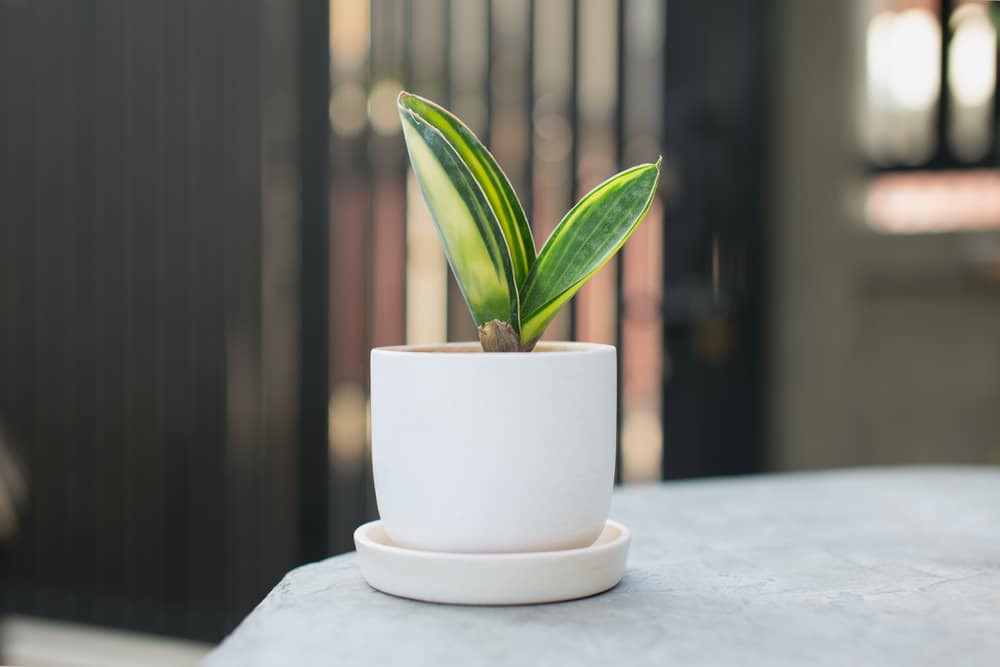Sansevieria masoniana is a type of snake plant and is often referred to as the whale fin snake plant or Mason’s Congo. If you’ve ever searched for beginner-friendly houseplants, you’re familiar with snake plants in general. They’re always near the top of the list, and Sansevieria masoniana is no exception.
If you’re not well-versed in caring for plants but want something striking and hardy, consider the search over! On the other hand, if you’ve got a green thumb, the whale’s fin snake plant is still a marvelous addition to the collection. After all, one simply cannot have too many snake plants.
| Common Name | Whale’s fin snake plant, Mason’s Congo |
| Botanical Name | Sansevieria masoniana |
| Native Areas | DRC (Democratic Republic of Congo) |
| Sun/Light Requirements | Low light tolerant but best in partial sun |
| Soil | Well-draining |
| Temperature | 65° to 75° F |
| Humidity | 5% to 25% but tolerant of any level |
| Size | 2 to 3 ft. in height |
| Hardiness Zones | USDA zones 10 to 11 |
Appearance
Sansevieria masoniana won’t be showing off with bright or beautiful flowers, but it does boast some very impressive leaves. Like all snake plants – they’re its calling card. The whale fin snake plant happens to be particularly good at growing very large ones.
Its leaves are typically dark green with a stiff, waxy feel to them and light green or white mottling. Beneath the surface (unfortunately out of sight most of the time) many Sansevieria masoniana have purple bands.
While there are many species of snake plants, most varieties do not go quite as tall as the whale fin snake plant. It might only grow a few leaves at a time, both those leaves get massive! These houseplants can grow up to three feet tall and there are reports of them stretching to heights well beyond that. That’s unlikely if they’re kept indoors, but if you ran into one in their native Congo, they might stand taller than you.
Sansevieria masoniana can flower, but you probably won’t see it happen to your houseplant. They’re very easy to keep and care for at home, but flowering takes perfect conditions that most plant owners can’t replicate. However, if you manage it, the flowers are white and form clusters along a stalk.
Care Instructions
Snake plants earned their reputation as easy houseplants for great reasons. They’re tolerant of just about any condition, including a wide range of light levels and humidity. Keeping them alive isn’t the problem. They’re hardy and stand up well to neglect (or just mismanagement).
However, just because your whale fin’s snake plant is alive doesn’t necessarily mean it’s thriving! Give it the best care possible and optimize conditions to see this perennial beauty stretch and sore into something impressive.
Sun/Light Requirements
When encountering snake plants in big box stores and garden centers, they’re often labeled as “low light” plants. This just isn’t true. Their native Democratic Republic of Congo is hardly a low-light situation, and there they enjoy bright sunlight for many hours a day. The labels would be more accurate if they tagged them as low-light tolerant.
The Sansevieria masoniana can handle everything from low-light setups to a few hours of bright, direct light each day. Optimal lighting is partial shade and partial sun. Your Sansevieria masoniana will thrive in the early morning sun near a window. Leggy growth is a telling sign that your plant needs more light.
It’s important to remember that snake plants are actually types of succulents. Keep that in mind when you see those “low light” labels – it’s unlikely that many people would put other types of succulents in those setups!
Watering
These plants are very drought tolerant, so err on the side of underwatering rather than overwatering. Wait until the soil is completely dry all the way to the bottom of the pot. Because they’re succulents, they retain a lot of water in their leaves, so it’s going to take an excessive amount of time for them to suffer without water.
Once the soil is completely dry, water thoroughly but slowly. You want to make sure the root ball is saturated, but nothing is being left soggy. It’s difficult to undo the damage of overwatering, which usually presents with mushy leaves. At that point, you’ll have to cut away all the soft areas and attempt to revive the plant with repotting. If you’re not sure if the soil is quite dry enough, give it an extra day or so to get there. Your whale fin snake plant can survive!
In the event that Sansevieria masoniana is underwatered for too long, its leaves will start to curl. At that point, it’s safe to increase the watering frequency a bit.
Soil
Sansevieria masoniana needs something very well-draining. You can use potting soil but mix in plenty of drainage material if that’s your chosen route. Pumice, perlite, and wood chips are all great options. Add in enough to ensure your plant isn’t sitting in water or too much moisture.
The best option for the whale fin snake plant is going to be a cactus mix. There are plenty of pre-made options on the market, but if you’re determined to make your own mix it’s simple enough. Unlike regular potting mix, cactus mix is primarily inorganic. Three parts potting soil, three parts sand, and two parts pumice is just one possible example.
In short, the goal is to get your whale fin snake plant in something well-draining.
Humidity and Temperature
Unsurprisingly, Sansevieria masoniana is also hardy in this category and is not choosy with humidity levels or temperature, so there’s no need to be overly concerned with either. Normal household temperatures and humidity levels are fine and won’t inhibit the plant.
Generally speaking, aim for 60-85℉ and lower humidity levels if possible, but you can take great care of your plant without making drastic adjustments to these levels.
Fertilizer
Fertilizer can certainly help your snake plant along, but take care not to overdo it and damage the plant. You can fertilize your whale fin snake plant in essentially the same way as other succulents. There are ready-made succulent fertilizers available, or you can use regular fertilizer diluted to ¼ strength.
Organic compost is also a fantastic option for these plants, whether you make your own at home or purchase it. Add a reasonably thick layer onto the top of your soil and water! Fertilizing is really only necessary during the growing season, so take a break during other parts of the year.
Pruning
Sansevieria masoniana doesn’t have a lot of pruning needs. This plant is slow-growing and it can take up to a year to produce a second leaf after its first one! Needless to say, you don’t want to do a lot of cutting and prodding for a plant that puts so much energy into production.
The only time pruning is necessary is if you spot a dead leaf or notice signs of disease and rot. At that point, remove any affected part of the plant. Depending on the cause, it might need repotting to have a chance of recovery.
Repotting
You can repot your whale fin snake plant every year or do it every two or three years instead. If you choose to repot annually, you won’t need to fertilize the plant at all – fresh soil provides plenty of nutrients for the year. This plant does tend to favor a tighter root system, though, so waiting a couple of years between repotting is best.
There are no particular twists and turns when repotting Sansevieria masoniana – just be careful not to damage the roots!
Propagating
Leaf cuttings are the easiest way to propagate Sansevieria masoniana, as growing them from seeds is quite a process. To propagate with a leaf cutting, take a whole leaf or a section of a leaf and place it in a dish or vase of water. Keep it in bright light (but indirect) light and change out the water about once a week until you see roots begin to form.
After your cutting has a couple of inches of root growth, pot them in your soil and resume a regular watering schedule (meaning once the soil is entirely dry). This plant is very slow growing, so settle in. You’ll see a new leaf in about a year, or just several months if you’re lucky. It’s a good thing they’re worth the wait!
Pests and Insects
Overwatering is dangerous for Sansevieria masoniana. Root rot is the biggest concern, but overwatering also invites insects and pests. This plant is fairly resistant to pests in general, but if you spot any signs of them, it’s safe to treat your whale fin snake plant with plant-safe soaps and oils.
Final Thoughts
For greenery that lasts all year and doesn’t require a lot of plant-parenting skills, bring home a Sansevieria masoniana. These low-maintenance wonders are happy in practically any setup, and it doesn’t take much effort to keep them that way. It’s all worthwhile when you celebrate that long-coming, painstakingly grown new leaf!

